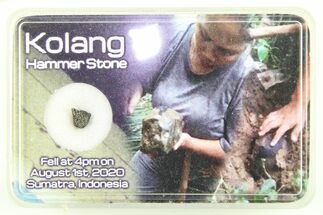This Specimen has been sold.
.17" Winchcombe Meteorite Fragment - Landed in Families Driveway
This is quite the astronomical specimen: a .17" wide fragment of the Winchcombe meteorite, a witnessed fall that landed on a family's driveway in Winchcombe, England on February 28, 2021. Comes with the pictured display case.
About The Winchcombe Meteorite
Winchcombe is the name given to a carbonaceous chondrite that landed on an English driveway on February 28, 2021. At just about 9:00 PM local time, observatories and meteor observation cameras around the British Isles picked up a bolide making way for the United Kingdom. Numerous witnesses in England recalled a sonic boom over. The next morning, the Wilcock family of Winchcombe, Gloucestershire woke up to their driveway covered in powder and a pile of stones that left a small dent in the tarmac. The Wilcocks reported the impact to the UK Meteor Observation Network, eventually collecting about 600 grams from their property and from neighbors. Later laboratory analysis revealed that the Winchcombe stones are about 4.6 billion years old--as old as the solar system!--and likely originated from the asteroid belt.
Winchcombe is a CM carbonaceous chondrite, typically a dark brecciated stone with black to almost brownish fusion crust on larger fragments. Much of the meteorite is in powder form, and the intact stones are still quite crumbly.
Because it was collected so quickly after its fall, Winchcombe is considered quite a pristine meteorite that offers scientists a wealth of information about asteroids as they exist before falling to Earth as meteors. The roughly meter-wide impact crater was also removed from the Wilcocks' driveway shortly after collection and is now on display at the Natural History Museum in London.
Winchcombe is the name given to a carbonaceous chondrite that landed on an English driveway on February 28, 2021. At just about 9:00 PM local time, observatories and meteor observation cameras around the British Isles picked up a bolide making way for the United Kingdom. Numerous witnesses in England recalled a sonic boom over. The next morning, the Wilcock family of Winchcombe, Gloucestershire woke up to their driveway covered in powder and a pile of stones that left a small dent in the tarmac. The Wilcocks reported the impact to the UK Meteor Observation Network, eventually collecting about 600 grams from their property and from neighbors. Later laboratory analysis revealed that the Winchcombe stones are about 4.6 billion years old--as old as the solar system!--and likely originated from the asteroid belt.
Winchcombe is a CM carbonaceous chondrite, typically a dark brecciated stone with black to almost brownish fusion crust on larger fragments. Much of the meteorite is in powder form, and the intact stones are still quite crumbly.
Because it was collected so quickly after its fall, Winchcombe is considered quite a pristine meteorite that offers scientists a wealth of information about asteroids as they exist before falling to Earth as meteors. The roughly meter-wide impact crater was also removed from the Wilcocks' driveway shortly after collection and is now on display at the Natural History Museum in London.
About CM2 Carbonaceous Chondrites
Carbonaceous chondrites are a rare and scientifically significant type of stony meteorite, representing only about 4% of all meteorites found on Earth. These meteorites are considered to be some of the oldest materials in the solar system, dating back over 4.5 billion years. They are composed primarily of silicate minerals but are unique for their high levels of carbon, organic compounds, and water-bearing minerals, offering a glimpse into the conditions of the early solar system.
Theys are divided into several groups, including CI, CM, CR, CO, CV, and CK, each representing different compositions and histories. CI and CM chondrites are the most primitive and are often rich in organic compounds. CI chondrites, like the Orgueil meteorite, are extremely rare and contain the highest known concentrations of organic materials among meteorites.
A CM2 chondrite is a type of carbonaceous chondrite meteorite with a high abundance of carbon and water-bearing minerals. The “CM” classification stands for the "Mighei-type," named after a meteorite that fell in Mighei, Ukraine. The "2" in CM2 indicates a specific petrologic (textural) type, meaning it has experienced low levels of alteration from water or heat compared to other chondrites, preserving more primitive materials.
Carbonaceous chondrites are a rare and scientifically significant type of stony meteorite, representing only about 4% of all meteorites found on Earth. These meteorites are considered to be some of the oldest materials in the solar system, dating back over 4.5 billion years. They are composed primarily of silicate minerals but are unique for their high levels of carbon, organic compounds, and water-bearing minerals, offering a glimpse into the conditions of the early solar system.
Theys are divided into several groups, including CI, CM, CR, CO, CV, and CK, each representing different compositions and histories. CI and CM chondrites are the most primitive and are often rich in organic compounds. CI chondrites, like the Orgueil meteorite, are extremely rare and contain the highest known concentrations of organic materials among meteorites.
A CM2 chondrite is a type of carbonaceous chondrite meteorite with a high abundance of carbon and water-bearing minerals. The “CM” classification stands for the "Mighei-type," named after a meteorite that fell in Mighei, Ukraine. The "2" in CM2 indicates a specific petrologic (textural) type, meaning it has experienced low levels of alteration from water or heat compared to other chondrites, preserving more primitive materials.
TYPE
Carbonaceous Chondrite (CM2)
LOCATION
Winchombe, Gloucestershire, England
SIZE
.17" wide
CATEGORY
SUB CATEGORY
ITEM
#285694
 Reviews
Reviews












